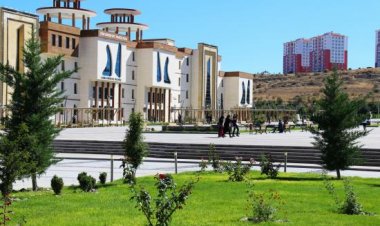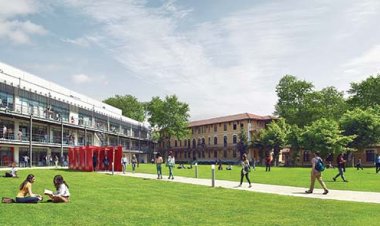Zebra kaktüsü (haworthia sp.)’nün doku kültürü yöntemi ile çoğaltımı üzerine araştırmalar
Zebra kaktüsü (haworthia sp.)’nün doku kültürü yöntemi ile çoğaltımı üzerine araştırmalar Solmaz, Emine Yeşil alanlara duyulan ihtiyacın ve kuraklığın giderek arttığı günümüzde ekstrem çevre koşullarına uyum sağlayabilecek çok sayıda bitkiye ihtiyaç duyulmaktadır. Sukulent bitkiler bu amaca hizmet eden önemli bir bitki grubunu oluşturmaktadır. Haworthia gerek süs bitkisi olarak gerekse tıbbi amaçlarla kullanılan ekonomik değeri yüksek önemli sukulent bitki cinslerinden biri olup Xanthorrhoeaceae familyasında yer almaktadır. Süs bitkileri yetiştiriciliğinde en önemli türlerinden biri olan Haworthia fasciata (Willd.) Haw., dekoratif yaprakları ile alana canlılık katan, bakımı kolay olması nedeniyle kullanıcılar tarafından tercih edilen, çok yıllık küçük yapılı bitkilerdir. Bu araştırmada Haworthia fasciata ‘Alba’kültivarının doku kültürü yöntemi ile mikroçoğaltımı üzerinde çalışılmıştır. Temel besin ortamı olarak %3 sakaroz ile %0.7 agar içeren MS, eksplant kaynağı olarak ise genç yapraklar kullanılmıştır. İn vitro adventif sürgün rejenerasyonu üzerine eksplant tipi ve büyümeyi düzenleyici maddelerin etkisi araştırılmıştır. Yaprak tabanı içeren tam yaprakların eksplant olarak kullanıldığı ve büyümeyi düzenleyici içeren besin ortamı kombinasyonlarından olumlu sonuçlar alınmıştır. Büyümeyi düzenleyici içermeyen kontrol grubu (MS) uygulamalarında herhangi bir organogenesis meydana gelmemiş, 2,4-D içeren uygulamalarda ise gelişme kallus şeklinde olmuş, bitkiye dönüşüm gerçekleşmemiştir. IAA içeren oksin sitokinin kombinasyonlarından en yüksek sayıda adventif sürgünler elde edilmiştir. En yüksek sayıda sürgünler 1.0 mg/L BAP+0.5 mg/L IAA (4.67±0.58 adet), 1.0 mg/L Kinetin+ 1.0 mg/L IAA (4.25±0.50 adet) ve 2.0 mg/L Kinetin+ 1.0 mg/L IAA (4.00±0.82 adet) uygulamalarında tespit edilmiştir. Elde edilen sürgünler in vitro koşullarda büyümeyi düzenleyici içeren veya içermeyen MS ve ½ MS ortamında başarılı bir şekilde köklendirilmiştir. Köklendirilen bitkicikler torf, perlit + torf (3:1) torf + pomza taşı (3:1) karışımı ile eşit oranlarda torf + perlit + pomza taşı karışımlarında başarılı bir şekilde %100 oranında dış koşullara alıştırılmıştır.; Today, the need for green areas and drought is increasing daily, and there is a need for many plants that can adapt to extreme environmental conditions. Succulent plants constitute an important plant group that serves this purpose. Haworthia, it is one of the important succulent plant genera with high economic value, used both as an ornamental plant and for medicinal purposes, and is in the Xanthorrhoeaceae family. Haworthia fasciata (Willd.) Haw. which is one of the most important species in ornamental plant cultivation, is a small perennial plant that adds vitality to the area with its decorative leaves and is preferred by users due to its easy care. This study is about the icropropagation of Haworthia fasciata ‘Alba’ cultivar by tissue culture method. MS containing 3% sucrose and 0.7% agar was used as the basal nutrient medium, and young leaves were used as explant. The effects of explant type and growth regulators on in vitro adventitious shoot regeneration were investigated. Positive results were obtained from combining whole leaves containing leaf bases as explants and nutrient media containing growth regulators. No organogenesis occurred in the control group (MS) applications that did not contain growth regulators, while the development was in the form of callus in the applications containing 2,4-D, and no transformation into the plant occurred. The highest number of adventitious shoots were obtained from the combinations of auxin cytokinins containing IAA. The highest number of shoots 1.0 mg/L BAP+0.5 mg/L IAA (4.67±0.58 units), 1.0 mg/L Kinetin+ 1.0 mg/L IAA (4.25±0.50 units) and 2.0 mg/L Kinetin+ 1.0 mg/L IAA (4.00±0.82). The resulting shoots were successfully rooted in MS and ½ MS medium with or without growth regulators in vitro. Rooted plantlets were successfully acclimatized to external conditions at a ratio of 100% in the mixture of peat, perlite + peat (3:1), peat + pumice stone (3:1) and peat + perlite + pumice stone in equal proportions.

Zebra kaktüsü (haworthia sp.)’nün doku kültürü yöntemi ile çoğaltımı üzerine araştırmalar Solmaz, Emine Yeşil alanlara duyulan ihtiyacın ve kuraklığın giderek arttığı günümüzde ekstrem çevre koşullarına uyum sağlayabilecek çok sayıda bitkiye ihtiyaç duyulmaktadır. Sukulent bitkiler bu amaca hizmet eden önemli bir bitki grubunu oluşturmaktadır. Haworthia gerek süs bitkisi olarak gerekse tıbbi amaçlarla kullanılan ekonomik değeri yüksek önemli sukulent bitki cinslerinden biri olup Xanthorrhoeaceae familyasında yer almaktadır.
Süs bitkileri yetiştiriciliğinde en önemli türlerinden biri olan Haworthia fasciata (Willd.) Haw., dekoratif yaprakları ile alana canlılık katan, bakımı kolay olması nedeniyle kullanıcılar tarafından tercih edilen, çok yıllık küçük yapılı bitkilerdir. Bu araştırmada Haworthia fasciata ‘Alba’kültivarının doku kültürü yöntemi ile mikroçoğaltımı üzerinde çalışılmıştır. Temel besin ortamı olarak %3 sakaroz ile %0.7 agar içeren MS, eksplant kaynağı olarak ise genç yapraklar kullanılmıştır. İn vitro adventif sürgün rejenerasyonu üzerine eksplant tipi ve büyümeyi düzenleyici maddelerin etkisi araştırılmıştır. Yaprak tabanı içeren tam yaprakların eksplant olarak kullanıldığı ve büyümeyi düzenleyici içeren besin ortamı kombinasyonlarından olumlu sonuçlar alınmıştır.
Büyümeyi düzenleyici içermeyen kontrol grubu (MS) uygulamalarında herhangi bir organogenesis meydana gelmemiş, 2,4-D içeren uygulamalarda ise gelişme kallus şeklinde olmuş, bitkiye dönüşüm gerçekleşmemiştir. IAA içeren oksin sitokinin kombinasyonlarından en yüksek sayıda adventif sürgünler elde edilmiştir. En yüksek sayıda sürgünler 1.0 mg/L BAP+0.5 mg/L IAA (4.67±0.58 adet), 1.0 mg/L Kinetin+ 1.0 mg/L IAA (4.25±0.50 adet) ve 2.0 mg/L Kinetin+ 1.0 mg/L IAA (4.00±0.82 adet) uygulamalarında tespit edilmiştir. Elde edilen sürgünler in vitro koşullarda büyümeyi düzenleyici içeren veya içermeyen MS ve ½ MS ortamında başarılı bir şekilde köklendirilmiştir. Köklendirilen bitkicikler torf, perlit + torf (3:1) torf + pomza taşı (3:1) karışımı ile eşit oranlarda torf + perlit + pomza taşı karışımlarında başarılı bir şekilde %100 oranında dış koşullara alıştırılmıştır.;
Today, the need for green areas and drought is increasing daily, and there is a need for many plants that can adapt to extreme environmental conditions. Succulent plants constitute an important plant group that serves this purpose. Haworthia, it is one of the important succulent plant genera with high economic value, used both as an ornamental plant and for medicinal purposes, and is in the Xanthorrhoeaceae family. Haworthia fasciata (Willd.) Haw. which is one of the most important species in ornamental plant cultivation, is a small perennial plant that adds vitality to the area with its decorative leaves and is preferred by users due to its easy care. This study is about the icropropagation of Haworthia fasciata ‘Alba’ cultivar by tissue culture method. MS containing 3% sucrose and 0.7% agar was used as the basal nutrient medium, and young leaves were used as explant. The effects of explant type and growth regulators on in vitro adventitious shoot regeneration were investigated. Positive results were obtained from combining whole leaves containing leaf bases as explants and nutrient media containing growth regulators. No organogenesis occurred in the control group (MS) applications that did not contain growth regulators, while the development was in the form of callus in the applications containing 2,4-D, and no transformation into the plant occurred. The highest number of adventitious shoots were obtained from the combinations of auxin cytokinins containing IAA. The highest number of shoots 1.0 mg/L BAP+0.5 mg/L IAA (4.67±0.58 units), 1.0 mg/L Kinetin+ 1.0 mg/L IAA (4.25±0.50 units) and 2.0 mg/L Kinetin+ 1.0 mg/L IAA (4.00±0.82). The resulting shoots were successfully rooted in MS and ½ MS medium with or without growth regulators in vitro. Rooted plantlets were successfully acclimatized to external conditions at a ratio of 100% in the mixture of peat, perlite + peat (3:1), peat + pumice stone (3:1) and peat + perlite + pumice stone in equal proportions.

 Bilgi
Bilgi 















